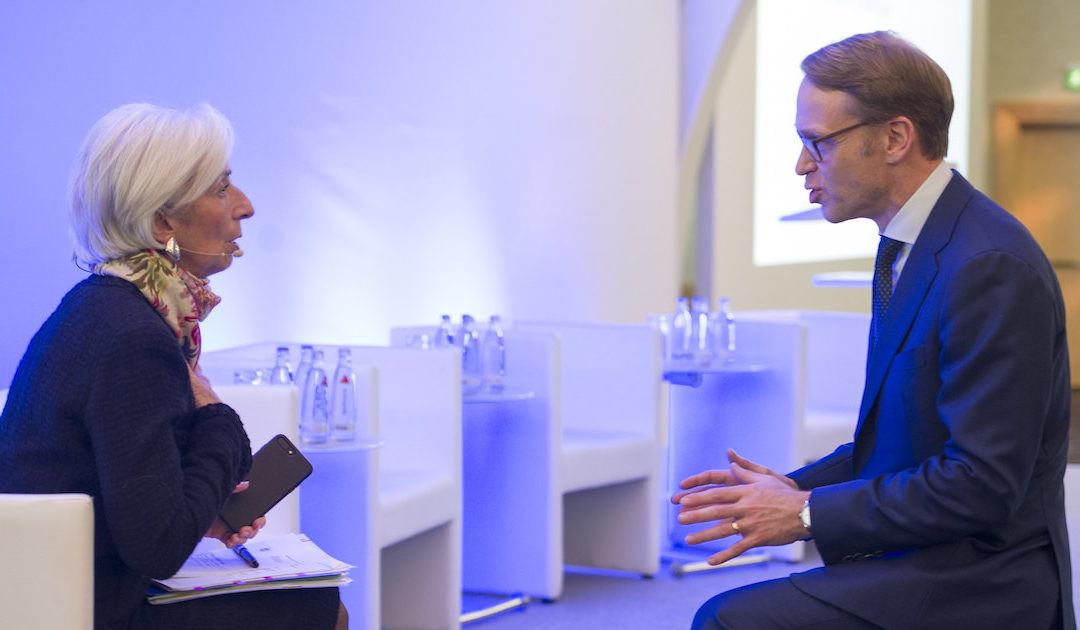In a recent speech, the Bundesbank’s President opposed “green quantitative easing” for legal, technical and political reasons. But a closer examination shows his objections are weak and largely surmountable.
In a speech delivered on 29 October 2019 in Frankfurt, the German central banker Jens Weidmann said he supports the inclusion of climate-related risks in central bank’s supervision policies, but opposed the idea of aligning monetary policy itself with climate objectives.
“I am very critical when people say that monetary policymakers need to “go green” by launching “green QE”, say, or granting specific privileges to green assets within the collateral framework.” Weidmann said.
Since 2015, Positive Money has been one of the leading NGOs behind the “green quantitative easing” campaigns in Europe. Although Weidmann’s opposition to our proposals is certainly not new, it is the first time that the Bundesbank President articulates his objections so clearly. In this respect, we feel a duty to respond to Mr Weidmann’s criticism. As we demonstrate below, they are weak and largely unsubstantiated.
It is important to clarify upfront that under the “Green QE” umbrella, we articulate two different approaches. First, we proposed the coordination of QE with a large-scale issuance programme of green bonds by the EIB and its national equivalents – a proposal which resonates very much with some of the “Green New Deal” proposals being discussed. Secondly, we have advocated the introduction of various green criteria into asset purchases programmes (and collateral frameworks) in order to create incentives for the entire financial sector to shift financial flows towards low-carbon investments.
Is green monetary policy illegal?
Weidmann’s first objection refers to the presupposed illegality of adopting green criteria in monetary policy operations:
“Our mandate is to preserve price stability, and policy implementation needs to be in line with [the] principle of market neutrality. Skewing asset purchases to green bonds, say, would run counter to this principle, which is anchored in Article 127 of the EU Treaty. “
This objection is well-known to us. As a result of extensive research, we found that the notion of “market neutrality” is very vague, and its legal basis is indirect and generally weak. In fact, the notion of market neutrality is a self-defined and self-imposed doctrine of the ECB, and certainly not a strict legal obligation. If the ECB wanted to revise or adopt a different principle, it would have all the power to do so.
It is also somewhat ironic that Mr Weidmann uses article 127 to justify climate inaction by the ECB, when in fact the very same article confers large legal leeway for the ECB to act on climate change. Article 127 famously reads that “Without prejudice to the objective of price stability, the ESCB shall support the general economic policies in the Union” which include environmental protection (Article 3 TEU). Mr Weidmann’s omission of this legal provision is very strange.
Article 11 TFEU also confers procedural duties on the ECB, and as recognised by the ECB itself, the Paris agreement binds all EU institutions including the ECB. All those arguments together, confer strong legal justifications for the ECB to act on climate change.
Central bank independence
Another dimension of Weidmann’s speech is the question of whether monetary policy instruments (and QE in particular) are adequate for tackling climate change.
According to Weidmann, “asset purchases need to be reserved for exceptional situations under the Eurosystem’s monetary policy framework and under no circumstances be deployed indefinitely. (…) After all, it is not immediately apparent why efforts to combat climate change should only be made when price pressures are weak.”
Here, Mr Weidmann is partly right that central bank policies should not make their policies contingent to climate goals. In order for the ECB not to sacrifice its price stability mandate, it should preserve its ability to phase out QE at any time.
While true in theory, the argument does not stand against the practical reality: the ECB is sitting on a gigantic 2.6 trillion euros stock of bonds which is unlikely to be sold back to the market in the near future. As the experience of the Federal Reserve has shown, QE can only be unwound slowly and carefully. In the meantime, allocating 500 or 1000 billion to green EIB bonds would be a more productive use of the ECB’s balance sheet, while leaving plenty of room for the ECB to sell the rest of its portfolio, or simply raise its key interest rates, if it needed to tame down inflationary pressures.
But there is more behind this technical issue. In fact, Mr Weidmann is afraid that the ECB would come under pressure for maintaining QE just because of the climate add-on goal. This fear sounds very hypothetical, and in any case, a manageable one. If the ECB has been so successfully independent for the last 20 years, it can certainly manage to say “no” to such hypothetical situation, once it has finally been able to raise inflation to its aim of 2%.
As Mario Draghi recalled in his farewell speech earlier this week, central bank independence should “not preclude communicating with governments when it is clear that mutually aligned policies would deliver a faster return to price stability. It means that alignment between policies, where needed, must serve the objective of monetary stability and should not work to the detriment of it”
This is exactly the type of opportunity that the ECB is contemplating today. Indeed, it is clear that an increase in green investment spending would strongly contribute to raising output and inflation, the precondition for the ECB to withdraw the QE stimulus, which Mr Weidmann desires so much.
Do central banks have the legitimacy to act?
Last but not least, Mr Weidmann questions the legitimacy of central banks to act on climate change, arguing that this would imply decisions (such as picking winners and losers) “which are not for central banks to take because they lack the requisite democratic legitimacy.”
First, Mr Weidmann seems to ignore the repeated calls by the European Parliament for the ECB to adjust its monetary policy to climate change. If resolutions adopted by the European Parliament – to whom the ECB is accountable to – do not confer some proof of democratic legitimacy on the ECB, what else will?
Second, it is worth stressing that we are not demanding that the ECB takes charge of climate change all alone, but rather that central banks do their best efforts – by using all their tools and policies – in contributing to the pre-existing EU’s strategy against climate change and objectives ratified by the Paris agreement.
For example, as envisaged by Christine Lagarde when speaking at the European Parliament, the ECB could build upon the upcoming EU’s green taxonomy and the EU green label and use it as a criterion for its collateral framework rules. Similarly, direct financial support to the EIB’s transformation into a Climate Bank would clearly limit the ECB’s role to deciding “how much” liquidity should be provided, and not on the particular investment projects which the EIB is lending to. Through such cooperation, the trade-offs pointed out by Mr Weidmann would be solved by other political institutions than the central bank.
To conclude, let us recall that we salute the work being done by central banks, including the Bundesbank, through the NGFS. The realisation of the huge financial risks implied by climate change is an important start in the reflexion on how to build a sustainable financial system. If done correctly, climate-risks assessment and their incorporation into the ECB’s risk management & collateral frameworks might ultimately lead to analogue effects than an outright “green QE” programme. However, we are deeply concerned that central banks are wasting too much time by relying solely on the prudential approach to climate change while excluding their monetary policy instruments from the discussion, as Mr Weidmann did.
The best defence against climate change is not just to measure how much damage will happen down the road as a result of political inaction, but to prevent such damage by ensuring financial flows are shifting speedily towards low-carbon investments.
Admittedly, the term “green quantitative easing” is somehow a confusing term, which is prone to certain misunderstandings. This is a sign that the time has come to move from such a slogan to an in-depth discussion on this issue. The question should not be whether but how should central bank’s monetary policy be involved, and draw up the institutional frameworks that are likely to be necessary for central banks to step in comfortably.
It is unfortunate that by ruling out “green QE”, some central bankers are attempting to close the door to this conversation even before any serious examination of those policy options can be done.

